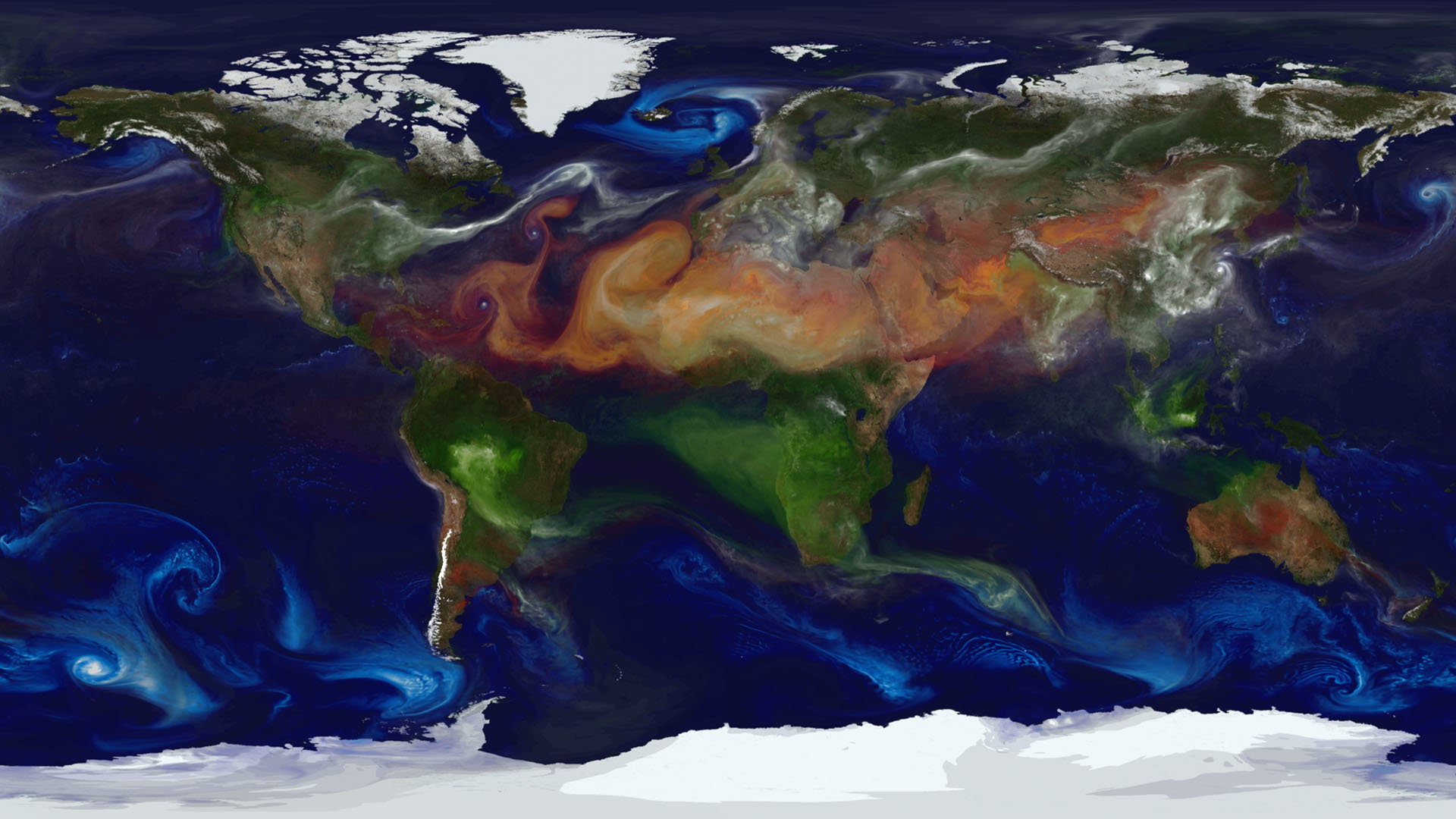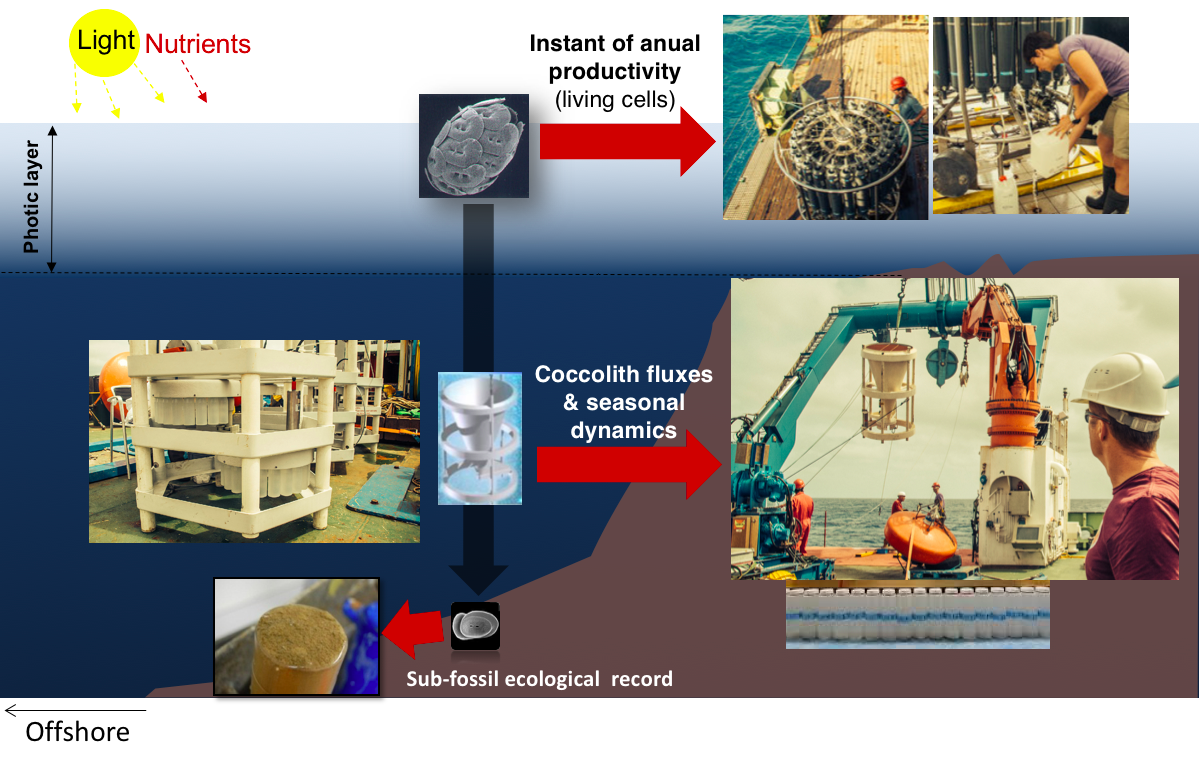BACKGROUND
Nutrients are blowing in the wind!
Did you know that massive amounts of tiny mineral particles originating from the continental deserts are transported by the wind over distances of thousands of km to be deposited on soil, plants and into the surface of the ocean [1]? It so happens that such desert dust typically carries nutrients (nitrogen - N, phosphorous - P; iron - Fe, zinc - Zn) that are essential for plants and marine phytoplankton to convert atmospheric CO2 into oxygen through performing photosynthesis. This is especially important in the context of “ocean deserts” in which high nutrient concentrations are too deep in the water column of the ocean, where light levels are often too low for allowing the algae to perform photosynthesis, and in High Nutrient Low Chlorophyll regions (HNLC), where primary production is often limited by Fe [2].
NASA models and supercomputing have created a colorful new view of aerosol movement. Source: https://svs.gsfc.nasa.gov/10977
The dust ballasting effect
Atmospheric dust is also thought to promote the sequestration of carbon from the productive photic layer down to the deep sea by acting as a mineral ballast of sinking organic-rich particles and aggregates, thereby accelerating the so-called "biological carbon pump" [3]. In fact, it has been recently demonstrated that more abundant and faster-sinking carbon-rich aggregates are generated when formed from a natural plankton community that has been exposed to dust deposition, compared to less abundant and slower-sinking aggregates that are formed without dust [4].
The Fe Hypothesis
By fertilising the ocean (nutrient source) and by accelerating the biological carbon pump (mineral ballasting effect), dust deposition is likely to change the Earth’s climate and atmospheric CO2. This so-called “Fe hypothesis” was first raised by John H. Martin in 1990, arguing that Fe input by desert dust may have played a major role in stimulating phytoplankton production in the past, leading to a significant drawdown of atmospheric CO2 during glacial times [5]. In addition, because phytoplankton are primary producers, dust-related changes in their productivity patterns are also likely to influence the remaining oceanic food web, thereby modifying the marine ecosystems as well as the fishing stocks.
Sahara desert: THE WORLD’S LARGEST SOURCE OF ATMOSPHERIC DUST
Of all the continental deserts, the Sahara is the world’s largest source of atmospheric soil dust. Around 200 million tons of Saharan-dust blown into and over the Atlantic every year are thought to supply nutrients for marine phytoplankton in the tropical North Atlantic, where N-fixation by marine phytoplankton is co-limited by Fe and P [6]. An increase of finer and clay-rich Saharan dust particles from east to west across the tropical North Atlantic has been reported by [7] and [8], reflecting the dust particles’ ability to remain suspended in the atmosphere and hence, to be transported over large distances.
Huge plumes of storm-blown Saharan dust as revealed from satellite images. Source: https://www.voanews.com/a/study-saharan-desert-dust-feeds-amazon-rainforest/2676025.html
WHY ARE WE exploring the effect of dust on COCCOLITHOPHORES’ production?
Coccolithophores (Haptophyta) are amongst the most important groups of phytoplankton in the nutrient-depleted (also called oligotrophic) regions of the global ocean, and hence they are natural inhabitants of the tropical North Atlantic [9]. They differ from other groups in that they cover their cells with tiny calcite plates (the coccoliths). This provides them the ability of directly interacting and influencing the carbon cycle not only through photosynthesis (CO2 sink), but also via calcification (CO2 source) and carbon-burial in deep-sea sediments (acting as a mineral ballast for the export of organic matter, in a similar way to that of dust particles) [10]. By also including more opportunistic taxa (r-selected) that quickly respond to short-term changes linked to nutrient input, coccolithophores provide interesting perspectives as indicators of ocean fertilisation by dust, and subsequent effects on the the organic and inorganic carbon pumps.
Being both photosynthetic and calcifying, coccolithophores can be studied directly from the photic layer of the ocean where phytoplankton typically thrives, from sediment trap devices collecting particles (hence, also coccoliths) over longer periods of time, and from oceanic sediments collecting their mean accumulated (paleo)ecological record.
In the course of former H2020-DUSTCO and ERC-DUSTTRAFFIC projects, we have reported on strong linkages between the distribution of coccolithophores and the westward geostrophic deepening of the thermocline/nutricline across the tropical North Atlantic. These observations lead us to hypothesise that changes in coccolithophore species composition and distribution in response to ongoing ocean warming are likely to result in community-level shifts in total organic and inorganic carbon production/export/ballasting by this group [11]. Our research also suggested that increasing Saharan dust outbreaks across the tropical North Atlantic could contribute to reduce the rain ratio either by fertilising coccolithophores (and phytoplankton s.l.) in the upper photic zone, and by promoting the export of carbon-rich material through dust- and coccolith-ballasting [12,13,14,15].
References
[1] Scheuvens and Kandler, 2014. On Composition, Morphology, and Size Distribution of Airborne Mineral Dust. In Mineral Dust: A Key Player in the Earth System. P. Knippertz and J.-B.W. Stuut (eds.), Springer Science C Business Media Dordrecht 2014, 15-49. [2] Jickells et al., 2005. Global iron connections between desert dust, ocean biogeochemistry and climate. Science (308), 67–71. [3] Pabortsava et al., 2017. Carbon sequestration in the deep Atlantic enhanced by Saharan dust, Nat. Geosci., 10, 189–194. [4] van der Jagt et al., 2018. The ballasting effect of Saharan dust deposition on aggregate dynamics and carbon export: Aggregation, settling, and scavenging potential of marine snow. Limnol. Oceanogr. 00, 1–9. [5] Martin, 1990. Glacial Interglacial CO2 change: The Iron Hypothesis. Pale oceanography 5(1), 1-13. [6] Goudie and Middleton, 2001. Saharan dust storms: nature and consequences. Earth. Sci. Rev. 56, 179–204. [7] Winter, et al., 1994. Biogeography of living coccolithophores in ocean waters. In: Coccolithophores, edited by: Winter, A. and Siesser, W., Cambridge Univ. Press, 161–177. [7] Korte, L. et al., 2017.Downward particle fluxes of biogenic matter and Saharan dust across the equatorial North Atlantic. Atmos. Chem. Phys. 17, 1–17. [8] van der Does, M. et al., 2020. Tropical rains controlling deposition of Saharan dust across the North Atlantic Ocean. Geophysical Research Letters, 47, e2019GL086867. [9] Winter, et al., 1994. Biogeography of living coccolithophores in ocean waters. In: Coccolithophores, edited by: Winter, A. and Siesser, W., Cambridge Univ. Press, 161–177.8 [10] Rost and Riebesell, 2004. Coccolithophores and the biological pump: responses to environmental changes. In: Coccolithophores from molecular processes to global impact. H. Thierstein; J. Young (Eds.) Berlin, Springer, 99-125. [11] Guerreiro, C.V., et al., 2019. Transatlantic gradients in calcifying phytoplankton (coccolithophore) fluxes, Progress in Oceanography 176, 102140. [12] Guerreiro, C. V. et al., 2017. Coccolithophore fluxes in the open tropical North Atlantic: influence of thermocline depth, Amazon water, and Saharan dust, Biogeosciences 14, 4577-4599. [13] Korte, L. et al., 2019. Effects of dry and wet Saharan dust deposition in the tropical North Atlantic Ocean, Biogeosciences Discussions. [14] Korte, L., et al., 2020. Multiple drivers of production and particle export in the western tropical North Atlantic. Limnology & Oceanography, 9999. [15] Guerreiro, C. V. et al. (in review). Carbonate fluxes by coccolithophore species between NW Africa and the Caribbean: implications for the biological carbon pump, submitted to Limnology & Oceanography.



